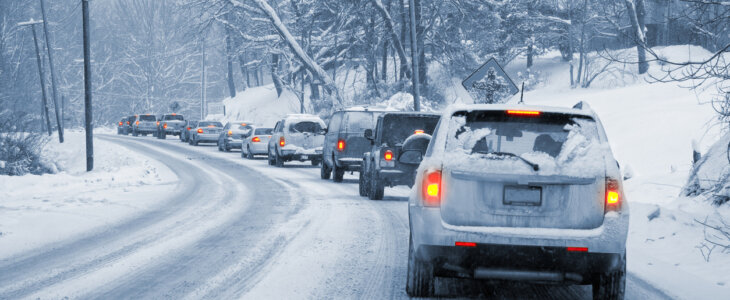As a personal injury attorney who represents clients involved in winter-related car accidents, I know the devastating impact these incidents can have on individuals and families. While the snow-covered landscapes of Illinois may look beautiful, they often conceal treacherous road conditions that can turn a routine drive into a life-altering event. In this blog post, I’ll share crucial information about winter driving dangers, along with tips to keep you safe on the roads this season.
The Sobering Statistics of Winter Driving
Before we talk about safety measures, it’s important to understand the scope of the problem. The numbers paint a stark picture of the risks associated with winter driving:
National Winter Driving Statistics
- Each year, an average of over 1,800 deaths and 136,000 injuries are attributed to icy and snowy road conditions
- Over 150,000 crashes occur annually due to icy roads alone
- About 17% of all vehicle crashes take place in snowy conditions
These statistics underscore the critical need for heightened awareness and caution when driving during winter months, especially in states like Illinois that experience severe winter weather.
Understanding the Hazards of Winter Driving
As a car accident attorney, I’ve investigated winter-related crashes. The most common hazards include:
- Reduced Traction – Icy and snowy roads significantly decrease tire grip, making it harder to control your vehicle. This can lead to skidding, sliding, and loss of control, especially when braking or turning.
- Poor Visibility – Heavy snowfall, freezing rain, and fog can severely limit visibility. This makes it difficult to see other vehicles, pedestrians, and potential hazards on the road.
- Black Ice – Perhaps the most insidious winter driving danger, black ice is a thin, transparent layer of ice on the road surface that’s nearly invisible to drivers. It can cause sudden loss of control and is particularly dangerous on bridges and overpasses.
- Increased Stopping Distance – Snowy or icy roads can increase your vehicle’s stopping distance by up to ten times. This means you need to maintain a much greater following distance than usual.
- Snow Buildup – Accumulated snow can obscure lane markings, road signs, and other important visual cues, making navigation more challenging.
The Role of Human Factors in Winter Accidents
While road conditions play a significant role in winter accidents, human factors often contribute to or exacerbate these incidents:
- Inadequate Vehicle Preparation – Many accidents occur because vehicles aren’t properly equipped for winter driving. This includes failing to install winter tires, neglecting to check brake systems, or not replacing worn windshield wipers.
- Overconfidence – Some drivers, especially those with four-wheel drive vehicles, overestimate their ability to handle winter conditions. This can lead to excessive speed and risky maneuvers.
- Distracted Driving – The dangers of distracted driving are amplified in winter conditions. Taking your eyes off the road for even a second can have catastrophic consequences when road conditions are poor.
- Fatigue – Winter driving requires heightened concentration, which can be mentally exhausting. Fatigue can slow reaction times and impair decision-making, increasing the risk of accidents.
Legal Implications of Winter-Related Accidents
I often field questions about liability in winter-related crashes. It’s important to understand that while adverse weather conditions can be a factor in accidents, drivers still have a legal responsibility to exercise due care. If a driver fails to adjust their driving to account for winter conditions and causes an accident, they may be held liable for any resulting injuries or damages. This is where the experience of a car accident lawyer becomes crucial. They can help determine factors such as:
- Whether the at-fault driver was driving too fast for conditions
- If proper vehicle maintenance was neglected (e.g., bald tires)
- Whether road authorities failed to adequately clear or salt roads
In some cases, multiple parties may share liability. For instance, if poor road maintenance contributed to the accident, a municipality might also bear some responsibility.
Essential Winter Driving Safety Tips
My goal is not just to represent clients after accidents occur, but to help prevent them in the first place. Here are some crucial safety tips for winter driving:
- Prepare Your Vehicle
- Install winter tires for improved traction
- Check your battery, as cold weather can reduce its effectiveness
- Ensure your windshield wipers and defrosters are in good working order
- Keep your gas tank at least half full to prevent fuel line freezing
- Plan Your Trip
- Check weather forecasts and road conditions before setting out
- Let someone know your route and expected arrival time
- Keep an emergency kit in your car, including blankets, flashlights, and non-perishable food
- Adjust Your Driving
- Reduce your speed and increase following distances
- Avoid sudden movements when braking, accelerating, or turning
- Be extra cautious on bridges, overpasses, and shaded areas where ice is likely to form
- Stay Alert
- Watch for snowplows and maintain a safe distance
- Be aware of black ice, especially in shaded areas and on bridges
- Keep your headlights on to improve visibility to other drivers
- Know How to Handle Skids
- If you start to skid, stay calm and steer in the direction you want to go
- Avoid slamming on the brakes, which can worsen the skid
When to Seek Legal Advice from An Accident Attorney
Despite our best efforts, accidents can still happen. If you’re involved in a winter-related car accident, it’s crucial to seek medical attention immediately, even if you feel fine. Some injuries may not be immediately apparent. After ensuring your health and safety, consulting with a personal injury lawyer or car accident attorney can help protect your rights. An experienced accident lawyer can:
- Help you navigate the complex claims process
- Ensure you receive fair compensation for your injuries and damages
- Investigate the accident to determine all liable parties
- Negotiate with insurance companies on your behalf
We offer free case evaluations, and you pay nothing until we win, so don’t hesitate to contact us for legal advice if you’re unsure about your rights or the strength of your case.
Conclusion
Winter driving presents unique challenges that require extra caution, preparation, and skill. By understanding the risks, preparing adequately, and adjusting your driving habits, you can significantly reduce your chances of being involved in a winter-related accident.
My hope is that by sharing this information, we can all work together to make our winter roads safer. Remember, if you do find yourself in need of legal assistance after a winter driving accident, don’t hesitate to reach out to a qualified car accident lawyer or personal injury attorney who can guide you through the process and help protect your rights. Stay safe out there, and remember: when it comes to winter driving, it’s always better to arrive late than not to arrive at all.


